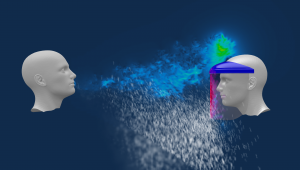Particle Distribution Simulation of a Sneeze
In normal times, a sneeze or a cough are not particularly alarming. In the era of COVID-19, however, a sneeze or cough in a public place is likely to send people running for cover. Sneezes and coughs can distribute potentially dangerous particles across a wide area – and because every sneeze or cough is different, it’s very difficult to predict where those particles could end up.
Right now, SIMULIA is working on doing just that. A team of experts has been working with simulation technology, particularly CFD, in order to study sneezes and coughs and how they disperse water droplets that could potentially distribute virus pathogens across surfaces and through the air. The team’s research started about nine years ago, but it had a different purpose: the focus was simulating water spray coming off of tires, as well as rain, dust and other kinds of particles for industrial purposes. When they heard about the need to simulate how viruses are being spread, they realized that they already had the right kind of physics for the simulation.
CFD allows not only a better understanding of how particles travel from sneezes and coughs, it enables more effective design of personal protective equipment (PPE).
“If we were going to do this experimentally, there would be a lot of issues with trying to get the same kind of sneeze each time,” says Jonathan Jilesen, Fluids Industry Process Senior Specialist with SIMULIA. “It’s also easier to quantify, as we can track each particle as it hits the surface and where it goes, so we can make very measurable differences between designs. We can also visualize the tracks of each trace, so that allows us to understand how they get where they’re going.”
Originally, the team had planned to study respiratory particles in order to design better inhalers. With the spread of COVID-19, however, the need to create better PPE is paramount. The CFD simulations allow the researchers to see how effective different variants of PPE are at keeping particles away from the people they are trying to protect.
Numerous mask designs are being shared online for makers to 3D print or otherwise fabricate, and while these makers’ intentions may be good, some designs are better than others, Jilesen says. The most effective designs need a component that goes over the forehead, forms a strong seal and keeps particles from coming down from above. The simulations have resulted in newer mask designs that are beginning to be distributed for better protection.
Simulating sneezes and coughs also allows the researchers to see how surfaces get contaminated, so that hospitals and public places can implement better cleaning measures. The data gathered from the simulations can be used to improve ventilation in not only hospitals but vehicles, which are especially dangerous places to be if someone coughs or sneezes. Better ventilation design could potentially keep virus particles from being redistributed through the air.
“There are really two different kinds of particles,” Jilesen explains. “There are the big ones that people can visibly detect, and you can understand where they’re going on the surfaces, but there are also smaller ones that will stay suspended in the air for much longer time. That’s why you want to be in the open air and not in the same room as someone who’s sick.”
In the video below, you can see how far particles can spread in an office setting – even when a sneeze is blocked in an elbow.
Other projects the team is working on include passenger placement in airplanes, in order to best prevent cross-contamination if a passenger is ill. They are also working with MIT to help design a shield to protect doctors when intubating patients.
All the research that is being done has led to some rather disturbing conclusions. For instance, virus particles can settle on a surface but then be reintroduced into the air, where they can stay for hours. If someone sneezes or coughs on you when you’re at the grocery store, the particles can land on your jacket, where they stay until the jacket is removed. At that point, the motion of the removal allows the particles to be launched back into the air.
The simulation results reflect what many doctors have warned of: virus particles, once introduced into the air, can remain for a very long time in a sort of cloud. This is how people can be sickened without being anywhere near someone who sneezes or coughs.
This information may be upsetting, but it explains a great deal about virus transmission and how it can be prevented – through better PPE, cleaning techniques, and ventilation. COVID-19 may seem to be an overwhelming problem at the moment, but scientists within SIMULIA and elsewhere are extremely busy working to bring it under control.
SIMULIA offers an advanced simulation product portfolio, including Abaqus, Isight, fe-safe, Tosca, Simpoe-Mold, SIMPACK, CST Studio Suite, XFlow, PowerFLOW and more. The SIMULIA Learning Community is the place to find the latest resources for SIMULIA software and to collaborate with other users. The key that unlocks the door of innovative thinking and knowledge building, the SIMULIA Learning Community provides you with the tools you need to expand your knowledge, whenever and wherever.
